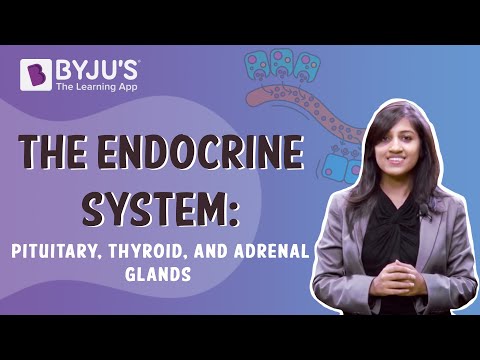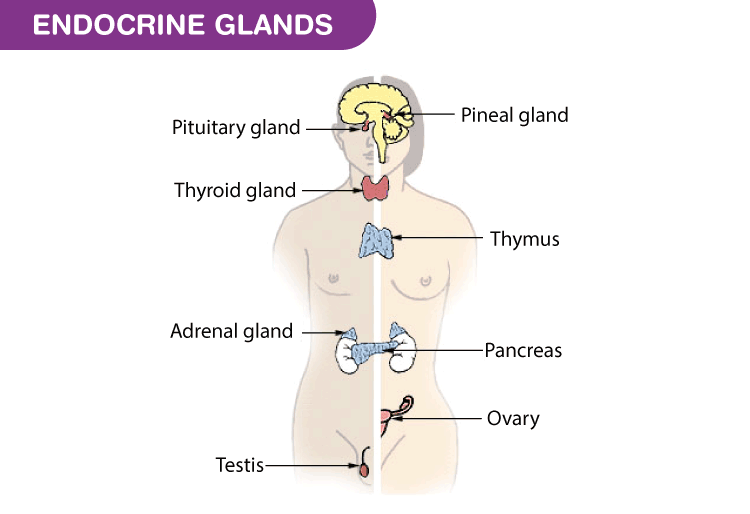In animals, there are two regulatory systems which help in homeostasis; they are the endocrine system and the nervous system. Each organ system has its own mode of regulation, for instance, the nervous system generates impulses for regulation whereas the endocrine system operates with endocrine glands that secrete chemicals called hormones. Let’s learn about various endocrine glands – parathyroid, thymus, adrenal, pancreas, testis, and ovary.

Ductless Glands
Endocrine glands are also known as the ductless glands because of the fact that their secretions are released directly into the blood, not to any tubes or ducts. Hypothalamus, Pituitary gland, Pineal body, Thyroid, Parathyroid, Adrenal glands, Pancreas, and Gonads are the major glands which make up the human endocrine system.
- Hypothalamus
- Gonads
- Pituitary gland
- Thyroid
- Pineal body
- Parathyroid
- Thymus
- Adrenal glands
- Pancreas
In this article, we will discuss the five ductless glands of the endocrine system and their functions that are listed below.

Parathyroid Gland
Parathyroid glands are four small glands present as pairs in each lobe of the thyroid gland. The gland produces parathyroid hormone (PTH) which regulates the level of calcium ions (Ca2+) in the blood. PTH regulates calcium level along with calcitonin by promoting breaking of bones, reabsorption by renal system and absorption of calcium ions from food. The normal bone destruction by osteoclasts in bone resorption that is triggered indirectly by PTH.
Thymus
The thymus gland is a lymphoid organ positioned between the two lungs behind the sternum. Structurally, it is a two-lobed gland forming a major part of the immune system. The peptide hormones, thymosins secreted by the thymus gland produce T-lymphocytes for the cell-mediated immunity and antibodies for humoral immunity. On arrival of puberty, the human thymus becomes much smaller and starts to disintegrate which in turn reduces the production of thymosins. This is why immunity in old individuals is generally weaker than the immunity in infants.
Adrenal Glands
Adrenal glands are two triangular shaped glands present at the top of each kidney. The outer cortex part secretes a hormone generally known as corticosteroids while inner medulla produces hormones generally known as catecholamines.

Catecholamines include two types of hormones, adrenaline (epinephrine) and noradrenaline (norepinephrine). These hormones are called as emergency hormones or hormones of fight/flight because they are released commonly under stress. During emergency situations, the level of adrenaline will be high in the blood. As a result, our body becomes more alert, starts sweating, the heartbeat increases and so does the cardiac output. The rate of cellular respiration also gets increased.
Corticosteroids (corticoids) are secreted from the three layers of the adrenal cortex, namely, zona reticularis, zona fasciculata and zona glomerulosa. Glucocorticoids (e.g. cortisol) and mineralocorticoids (e.g. aldosterone) are two corticoids which help in the metabolism of carbohydrates and regulation of electrolytes in our body. In addition, cortisol produces immune responses, anti-inflammatory reactions and stimulates RBC production. Other than corticoids, adrenal cortex also produces a minute amount of androgen that plays a role in secondary sexual characteristics.
Pancreas
The pancreas is both an endocrine as well as an exocrine gland. The endocrine part produces insulin and glucagon and helps to maintain an equilibrium of blood glucose level. These hormones are produced by the two types of cells of the Islet of Langerhans. They are alpha cells which secrete the hormone, glucagon while the beta cells secrete the hormone, insulin. Both of these hormones contradict each other’s actions.
Glucagon results in hyperglycemia by stimulating glycogenolysis and gluconeogenesis while insulin is a hypoglycemic hormone which increases glucose uptake and utilization by stimulating glycogenesis. A person who has prolonged hyperglycemia suffers from the endocrine disorder called diabetes mellitus. Such patients are treated with insulin.
Gonads
Gonads are the reproductive glands which include both male and female sex organs. Male gonad also called as testes, is the primary center which produces androgen. Testosterone is an important hormone among them. They are responsible for the secondary sexual characteristics of puberty and other hormonal regulations.
A pair of ovaries is the female gonad. They secrete two hormones namely estrogen and progesterone. Estrogen, the hormone that is synthesized by ovarian follicles, is responsible for secondary sexual characteristics during puberty. Both estrogen and progesterone together help in pregnancy and menstrual cycle in women.
Even though hormones secreted in the body are mainly contributed by the endocrine glands; organs — such as the brain, heart, lungs, kidneys, liver, placenta etc. — also secrete hormones

very informative . good for students
Nice and well explained,, I personally enjoyed thanks